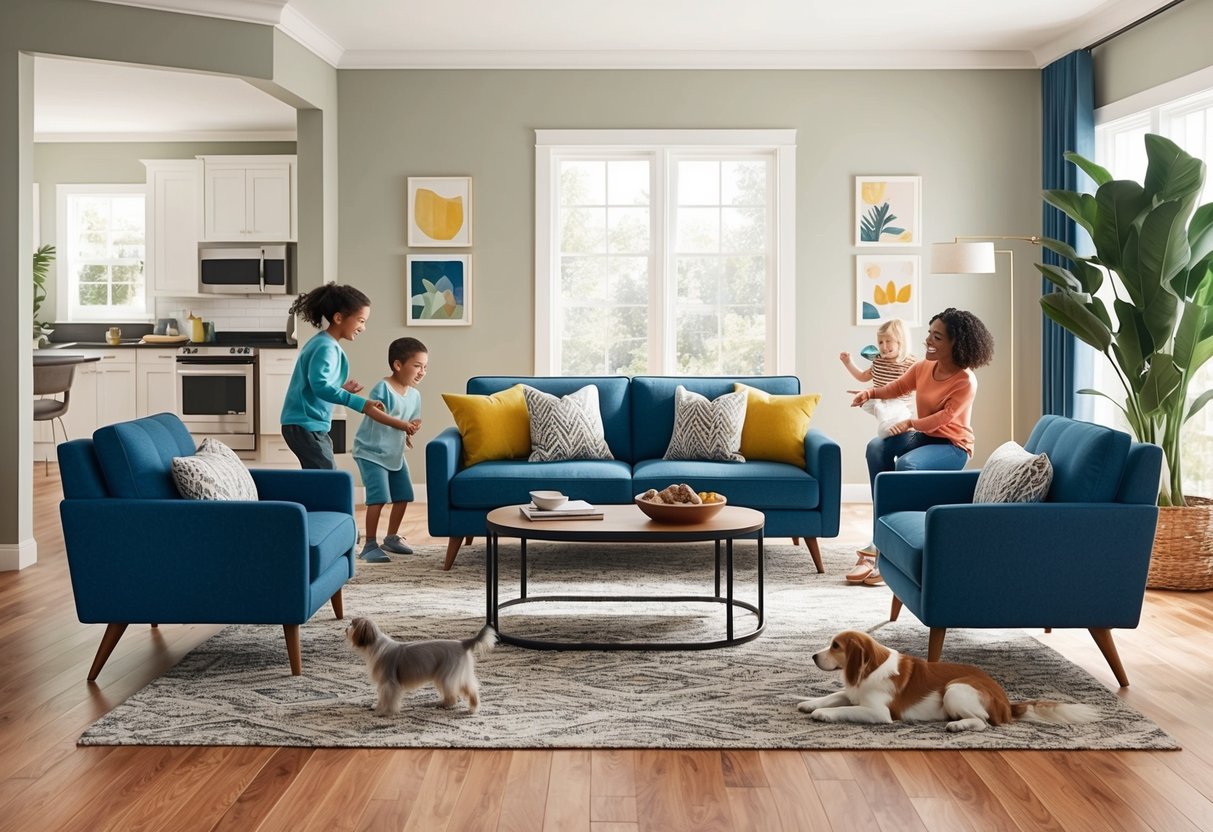
Choosing the right upholstery fabric is essential for any home where furniture faces constant use by kids, guests, or pets. Selecting durable, stain-resistant, and easy-to-clean materials can help sofas, chairs, and ottomans maintain their appearance even in high-traffic areas.
This means considering fabric options that offer abrasion resistance, colorfastness, and fabric weave styles designed to handle frequent wear and tear.
Homeowners often search for upholstery fabrics that balance comfort, style, and practicality. Popular options for high-traffic homes include microfiber, leather, and linen, each offering unique advantages in terms of soil resistance, cleanability, and longevity.
Fabrics like microfiber are favored for their dense weave and ability to repel liquids, while leather and linen are praised for their natural durability and resistance to abrasion. For a deeper dive into the specific qualities and advantages of these materials, visit this complete guide to selecting upholstery fabric.
Understanding the basics of fabric durability, cleanability, and how each material holds up over time will empower homeowners to make informed decisions.
Understanding Upholstery Fabrics
Selecting the right upholstery fabric plays a critical role in the comfort, look, and longevity of household furniture, especially in homes that see heavy daily use. The durability and cleaning requirements of different materials can affect not only how a sofa or chair feels, but also how well it stands up to the demands of busy spaces.
What Is Upholstery Fabric?
Upholstery fabric is a specialized textile designed to cover and protect furniture. It differs from regular fabric through its structure, strength, and the treatments it receives for durability and stain resistance.
Some common materials used for upholstery include cotton, polyester, microfiber, leather, and various blends. These fabrics are manufactured with a tighter weave and heavier backing than typical textiles.
This design allows them to resist abrasion, stretching, and pilling. Many upholstery fabrics also include finishes that repel liquids or prevent fading, making them well-suited for everyday use on sofas, chairs, and ottomans.
Difference Between Upholstery and Regular Fabrics
Upholstery fabrics are engineered to be much more robust than regular fabrics. While everyday textiles such as quilting cotton or linen are generally lightweight, upholstery-grade materials are thicker, denser, and more tightly woven.
This added strength is essential for withstanding constant friction and pressure in high-traffic applications. Regular fabrics prioritize softness, pattern, and drape.
In contrast, fabric for upholstery is selected for practical features such as abrasion resistance, soil repellency, and ease of cleaning. High-performance upholstery textiles can last several years longer than ordinary textiles, even under frequent use.
Some fabrics, such as microfiber and leather, are especially preferred for their ability to handle daily wear and accidental spills.
Why Fabric Choice Matters for High-Traffic Homes
In homes with children, pets, or frequent gatherings, furniture faces constant challenges—from spills and stains to pet hair and rough handling. Choosing tough and easy-to-clean upholstery fabrics can help furniture maintain its appearance and function for longer.
Fabrics like microfiber, leather, and durable synthetics are popular choices, as they resist soiling, fading, and wear. Upholstery fabric with a high double-rub count (an industry durability test) is also key for these environments.
Tightly woven materials, reinforced backing, and protective finishes ensure the fabric holds up even in the busiest settings. This careful selection reduces the risk of premature replacement and extends the life of both the upholstery and the underlying furniture.
Types of Upholstery Fabrics
Upholstery fabrics are selected based on factors like durability, resistance to stains, and ease of cleaning. High-traffic homes benefit most from materials that hold up well to frequent use, maintain their appearance, and are easy to care for over time.
Natural Fibers
Natural upholstery fabrics, such as cotton, linen, wool, and leather, are valued for their breathable texture, classic appearance, and comfort. Cotton is both soft and versatile, but it may require stain resistance treatments for households with frequent spills or pets.
Linen stands out for its strength and abrasion resistance, making it a strong choice for living rooms and busy family spaces. Leather is popular because of its robust durability, easy cleaning, and resistance to wear, which is especially helpful in high-traffic areas.
Natural fibers offer unique visual character and tend to feel cooler in the summer and warmer in winter. However, they can be prone to fading if exposed to direct sunlight and may not always be as resistant to staining or pilling as synthetics.
Synthetic Fibers
Synthetic fibers are engineered specifically to boost durability, stain resistance, and affordability. Common synthetic upholstery fabrics include polyester, nylon, acrylic, and olefin.
Polyester resists wrinkles and abrasions, while nylon’s strength makes it a solid choice for intense daily use. Acrylic can mimic natural wool but is more resistant to stains, fading, and mildew.
Olefin is well-known for its resistance to moisture and chemicals, making it ideal for families with children or pets. These fabrics are often tightly woven, extending their lifespan in high-traffic areas.
Synthetics frequently offer a broader color and design selection, often at a lower cost, and are found in many commercial and residential settings as high-performance upholstery options.
Blended Fabrics
Blended upholstery fabrics combine natural and synthetic fibers to balance comfort, strength, and style. Common blends include cotton-polyester, wool-nylon, and linen-viscose combinations.
These mixtures are designed to offer the softness or luxury of natural materials with the lasting power and easy care of synthetic fibers. A cotton-polyester blend, for instance, minimizes wrinkling and increases stain resistance while still feeling soft.
Blended fabrics are versatile, appearing in a range of textures, colors, and patterns to match many decor styles. They are engineered to achieve better performance in high-traffic interiors, making them one of the top choices for busy households that want both comfort and long-term value.